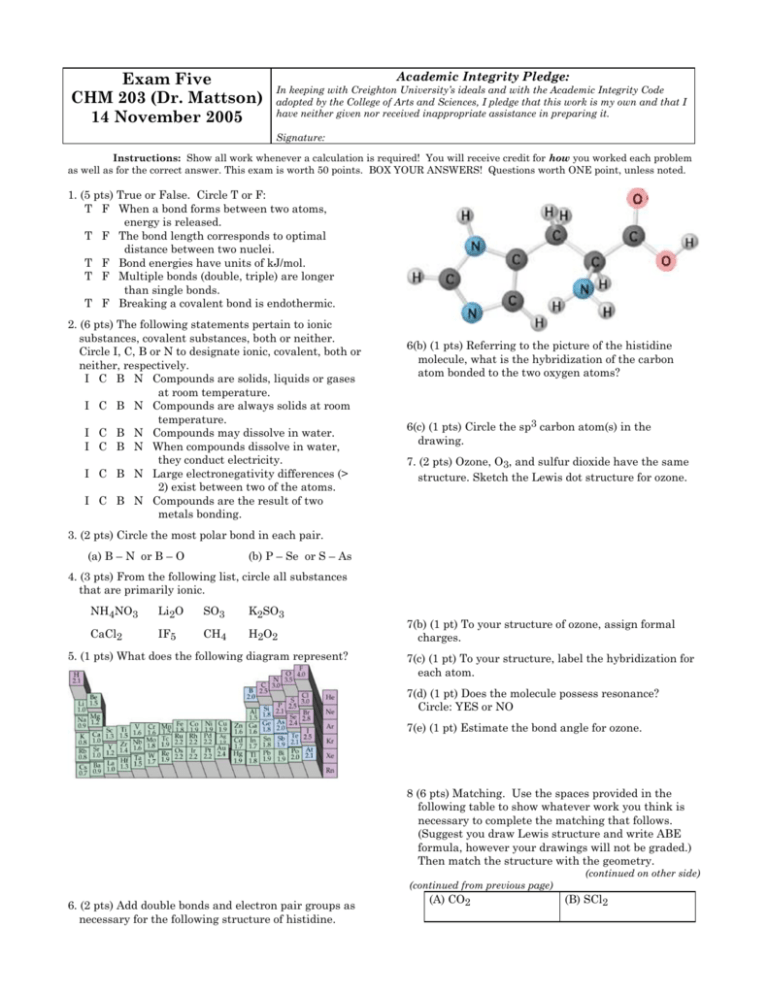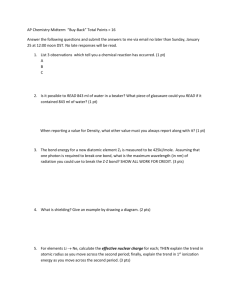F-05_Exam_5_Answers
advertisement

Exam Five CHM 203 (Dr. Mattson) 14 November 2005 Academic Integrity Pledge: In keeping with Creighton University’s ideals and with the Academic Integrity Code adopted by the College of Arts and Sciences, I pledge that this work is my own and that I have neither given nor received inappropriate assistance in preparing it. Signature: Instructions: Show all work whenever a calculation is required! You will receive credit for how you worked each problem as well as for the correct answer. This exam is worth 50 points. BOX YOUR ANSWERS! Questions worth ONE point, unless noted. 1. (5 pts) True or False. Circle T or F: T F When a bond forms between two atoms, energy is released. T F The bond length corresponds to optimal distance between two nuclei. T F Bond energies have units of kJ/mol. T F Multiple bonds (double, triple) are longer than single bonds. T F Breaking a covalent bond is endothermic. 2. (6 pts) The following statements pertain to ionic substances, covalent substances, both or neither. Circle I, C, B or N to designate ionic, covalent, both or neither, respectively. I C B N Compounds are solids, liquids or gases at room temperature. I C B N Compounds are always solids at room temperature. I C B N Compounds may dissolve in water. I C B N When compounds dissolve in water, they conduct electricity. I C B N Large electronegativity differences (> 2) exist between two of the atoms. I C B N Compounds are the result of two metals bonding. 6(b) (1 pts) Referring to the picture of the histidine molecule, what is the hybridization of the carbon atom bonded to the two oxygen atoms? 6(c) (1 pts) Circle the sp3 carbon atom(s) in the drawing. 7. (2 pts) Ozone, O3, and sulfur dioxide have the same structure. Sketch the Lewis dot structure for ozone. 3. (2 pts) Circle the most polar bond in each pair. (a) B – N or B – O (b) P – Se or S – As 4. (3 pts) From the following list, circle all substances that are primarily ionic. NH4NO3 Li2O SO3 K2SO3 CaCl2 IF5 CH4 H2O2 5. (1 pts) What does the following diagram represent? 7(b) (1 pt) To your structure of ozone, assign formal charges. 7(c) (1 pt) To your structure, label the hybridization for each atom. 7(d) (1 pt) Does the molecule possess resonance? Circle: YES or NO 7(e) (1 pt) Estimate the bond angle for ozone. 8 (6 pts) Matching. Use the spaces provided in the following table to show whatever work you think is necessary to complete the matching that follows. (Suggest you draw Lewis structure and write ABE formula, however your drawings will not be graded.) Then match the structure with the geometry. (continued from previous page) 6. (2 pts) Add double bonds and electron pair groups as necessary for the following structure of histidine. (A) CO2 (continued on other side) (B) SCl2 (C) SO3 (D) NH4+ (E) PH3 (F) PF5 11. (3 pts) Sulfur trioxide reacts instantaneously with water to produce sulfuric acid. When 3.0 g sulfur trioxide is reacted with 100.0 g water in a coffee cup calorimeter, the temperature of the water rises from 25.0 oC to 41.6 oC. What is H for the reaction as given below? You may assume that the solution has the same specific heat as pure water. [Given: specific heat of water is 4.184 J/g deg.] SO3(g) + H2O(l) (G) PF6- H2SO4(aq)H = ? (H) IF5 Match the structures above with the descriptions below. Enter “A”, “B” etc. Each used ONCE. _____ 1. octahedral 12. (3 pts) Calculate Hrxn for the following reaction _____ 2. linear [Given: Hf(kJ/mol): Ca3P2 = -504; H2O(l) = -286 _____ 3. tetrahedral CaO = -636; PH3 = +5.4] _____ 4. trigonal pyramid Ca3P2(s) + 2 H2O(l) _____ 5. square pyramid _____ 6. bent _____ 7. trigonal plane _____ 8. trigonal bipyramid 9. (3 pts) Inspect the hybridization drawing for C2H4. 13. (3 pts) Estimate H for this gas-phase reaction using bond energies. kJ/mol H S F H 436 340 570 S 340 225 310 F 570 310 159 H2S + 2 F2 9(a) What is the hybridization on the C atoms? 9(b) Which bond is a -bond? Circle: “A” or “B” 9(c) What is the carbon—carbon bond order? 10. Consider the reaction: 2 O3(g) 3 O2(g) H = -286 kJ 10(a) (1 pt) The reaction is [exothermic/endothermic] 10(b) (3 pts) Calculate q if 25 g ozone is converted into oxygen. (continued next column) 3 CaO(aq) + 2 PH3(g) 2 HF + SF2 14. (1 point) Print your name here: Your exam score (50 possible): PrenHall work (0 — 5 max.): Adjusted exam score (50 max.): Determine your grade: A > 46.5; B+ > 43.5; B > 41.0;C+ > 37.5; C > 34.00; D > 30.00 e 1. T T T F T 2. C I B I I N 3. (a) B – O (b) S – As 4. NH4NO3 Li2O K2SO3 CaCl2 5. periodic trends in electronegativity 6. (2 pts) 6(b) sp2 6(c) see figure 7. O O O 7(b) left O: 0 central O: +1 right O: -1 7(c) left O: sp2 central O: sp2 right O: sp3 7(d) YES 7(e) < 120 degrees 8. G A D E H B C F 9. a. sp2; b. A, c. 2 10. Consider the reaction: 2 O3(g) 3 O2(g) H = -286 kJ 10(a) exothermic 10(b) Calculate q = -74 kJ 11. H = -191 kJ 12. Hrxn = -821 kJ 13. H = -762





